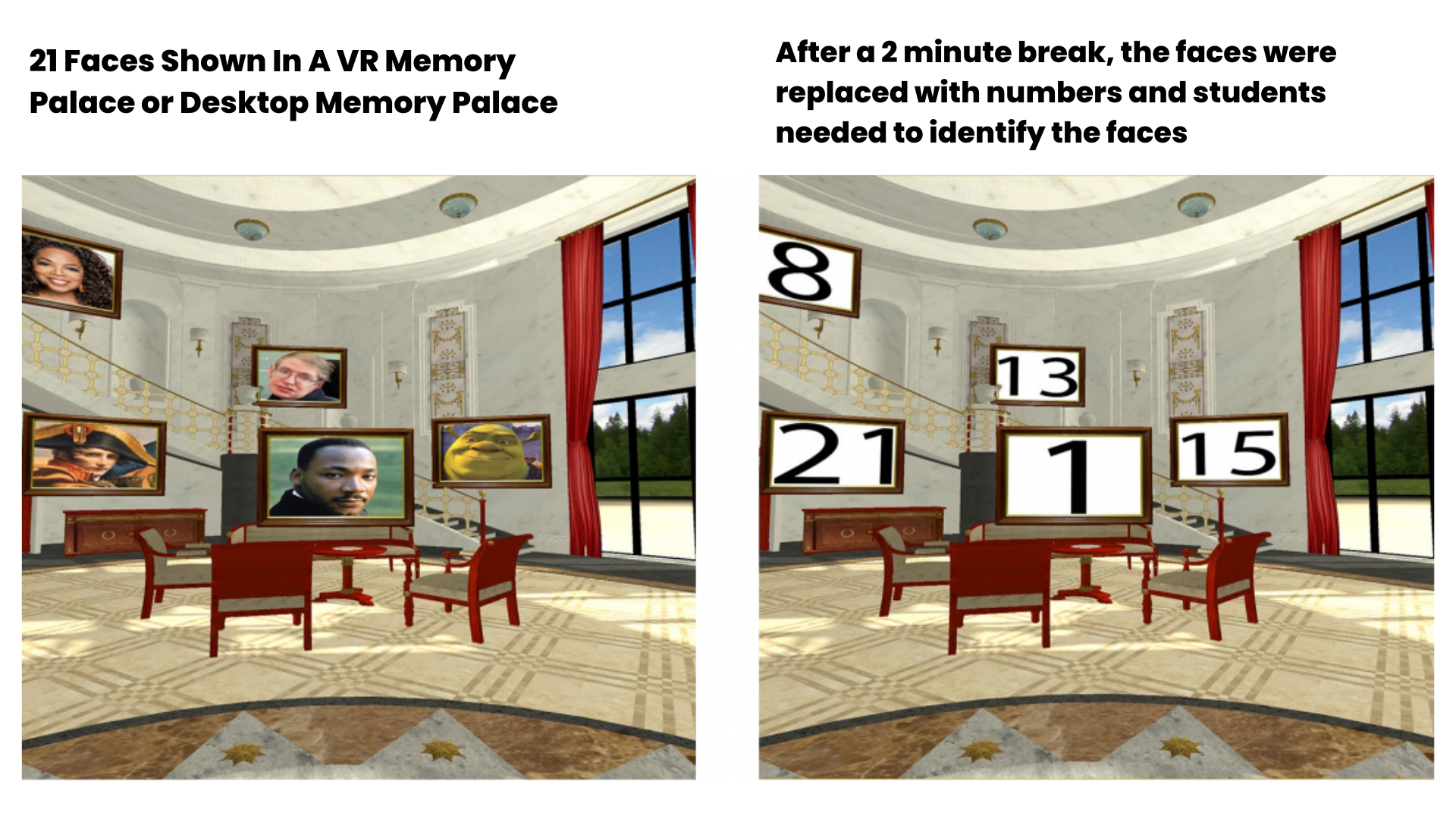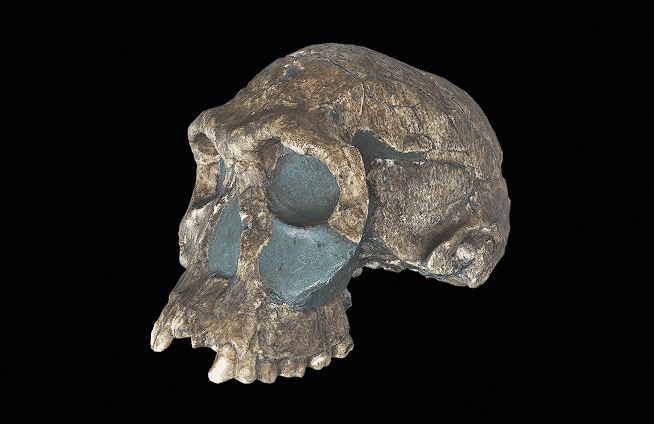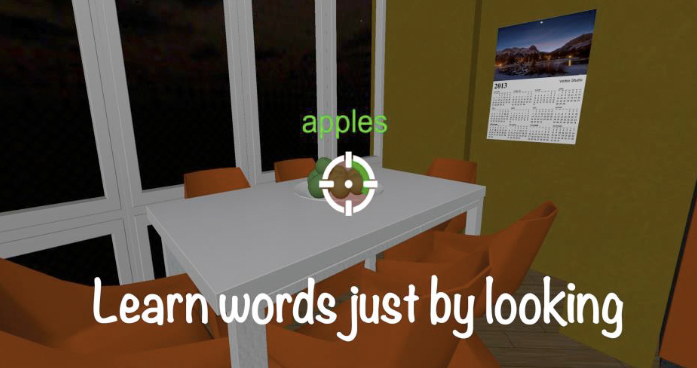It’s likely that within the next decade(s) VR technologies will be as ubiquitous as smartphones. This will make VR education more accessible and effective in higher education. Recent studies show that VR technology is beneficial for boosting students’ memory recall, increasing student resources in natural sciences, and improving language learning. Let’s break down three interesting VR case studies and examples.
1.Students in a VR memory palace were 11.9% more accurate in memory recall than students viewing the same memory palace on a desktop display
A memory palace is a memory technique in which you associate objects with spatial environments to help you recall those objects later. This study wanted to see if immersive VR memory palaces resulted in stronger memory recall than a memory palace viewed on a non-immersive desktop display.
In this study, the researchers gathered 40 students and showed them 42 famous faces and names on a piece of paper. The students spent 5 minutes familiarizing themselves with the faces and names.
Next, the students were divided into two groups, one using a VR memory palace and another using a desktop memory palace. Both memory places showed the same digital castle.
After the students spent 5 minutes familiarizing themselves with the castle, 21 well-known faces (like Shrek, Oprah, Martin Luther King Jr.) would show up around the castle. The students then had 5 minutes to associate the 21 faces with their locations in the castle.
The VR students rotated their bodies in place to see a 360 degree view of the castle, and the desktop students used mouse cursors to rotate the castle view.
After a 2 minute break in which the researchers asked the students random questions, the students went back to the memory palace. This time, all the faces were replaced with numbers, and students needed to verbally identify the names for each number.

In the picture example, if a student said “#1 is Martin Luther King Junior, #15 is Shrek,” then those would be correct answers.
After the students finished recalling the faces/names, the experiment was repeated again but this time the students who were in a VR memory palace went to a desktop memory palace, and vice versa. When it was repeated, the location was different (it was of a medieval town rather than a palace) and there were 21 new faces.
The researchers found that the median recall accuracy percentage when students were in the immersive VR environment was 90.48%, and when students were viewing the desktop display the median recall accuracy percentage was 78.57%. That is the difference between an A and C grade. Students were 11.9% more accurate in VR environments, suggesting that immersive landscapes aid in memory recall. These numbers are statistically significant, meaning it wasn’t due to random chance that the students were more accurate in VR memory palaces.
In a qualitative survey after the study, 70% of the students said they preferred the VR environment for this memory task because it improved their spatial awareness. That spatial awareness helped them associate the faces in relation to their body – for example, “Martin Luther King is in front of me, Vladimir Putin is behind me, Albert Einstein is to the left of me, etc.”
2.Anthropology students enjoyed greater accessibility to ancient human skulls thanks to VR courses
Anthropology students typically need to visit museums in order to look at ancient human skills in 3D. But the University of Oklahoma used VR technology to introduce a group of undergraduate students to hominid skull models in 3D.
These hominid skull models were obtained through existing 3D asset repositories such as African Fossils.

Image source: Ancient Fossils
The professor gave the students three tasks. In the first task, students looked at a virtual ancient skull and marked on it all the specific features they had learned about the skull previously.
The second task was to describe how the skull of an ancient young man, middle-aged man, and old man changes over time.
Finally, the third task showed two different skulls and asked students to identify which skull showed signs of a tougher or softer diet and why.
Although these tasks are possible to do with 2D pictures in a textbook or slideshow, they are not nearly as engaging and motivating for students. VR technology allowed the students to virtually touch and manipulate these 3D skulls that otherwise would’ve been inaccessible to them. Even at museums, skulls are often displayed behind glass containers, so students aren’t able to view them in all angles like they can in VR.
After the students completed the tasks, they were given surveys on their experiences. They reported higher confidence in doing spatial analysis and scale perception tasks.
The educational experiences will only improve as VR tech improves. For example, in the future students can go on a guided tour through a detailed model of Stonehenge, and they can even witness a timelapse of how researchers think Stonehenge was built over time.
3.VR helps students learn non-native languages through meaningful activities & immersive environments
The best way to learn a non-native language is to be completely immersed in it. VR technology makes that possible. A recent study finds that VR language learning apps help students learn non-native languages effectively for the following reasons:
- Students are immersed in authentic, real-life environments, which is the best way to learn languages
- Students enjoy multi-sensory environments (see people, see text while they talk, hear them talk, all at the same time)
- Students gain confidence by having a safe space to practice understanding and speaking a new language with fake people

For example, rather than reading textbook dialogue between a traveler and a hotel receptionist, students can be the travelers in a new country. They are immersed in an environment that looks like a hotel, and they can see the hotel receptionist. When the receptionist talks to the students, the students can both hear and read what they’re saying at the same time to increase listening and reading comprehension.
Of course, a student and teacher can roleplay as the traveler and receptionist without VR technology, but the environment isn’t as believable and it requires having both people available and together. The immersive environment increases student engagement and motivation because VR helps them feel like they’re actually traveling to a country where they speak a different language.
VR can also help students learn new vocabulary faster. For example, students can look at objects in a virtual environment and the object’s name can be displayed above it. The student can then practice speaking that object’s name each time they see it. If they pronounce the word incorrectly, the VR app can demonstratehow to pronounce it accurately.

Conclusion:
Many of the examples showed low-fidelity virtual environments, but the studies still found significant learning benefits. As VR hardware and software continue to grow in quality every year, students will enjoy higher quality environments and more opportunities to interact with the environment, which may lead to even greater benefits to learning in VR.
Feature Image Credit – Champ Panupong Techawongthawon



